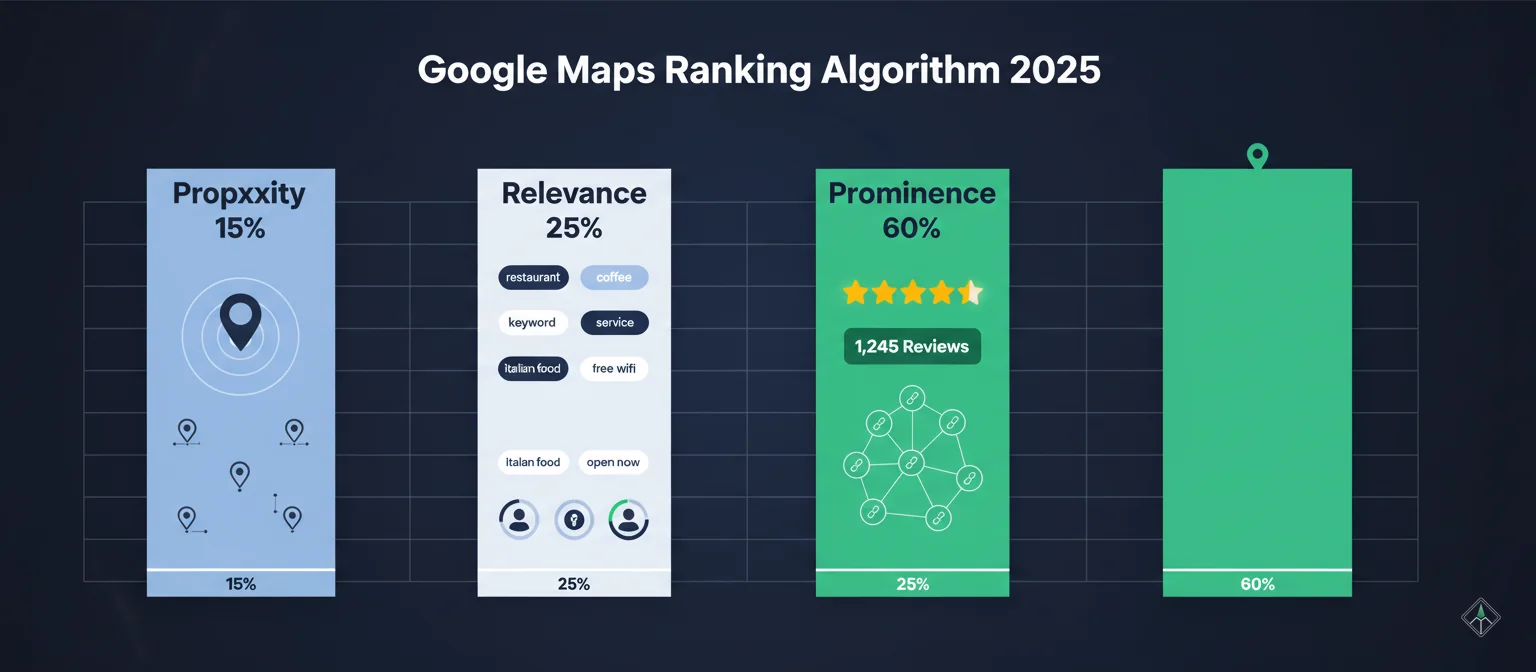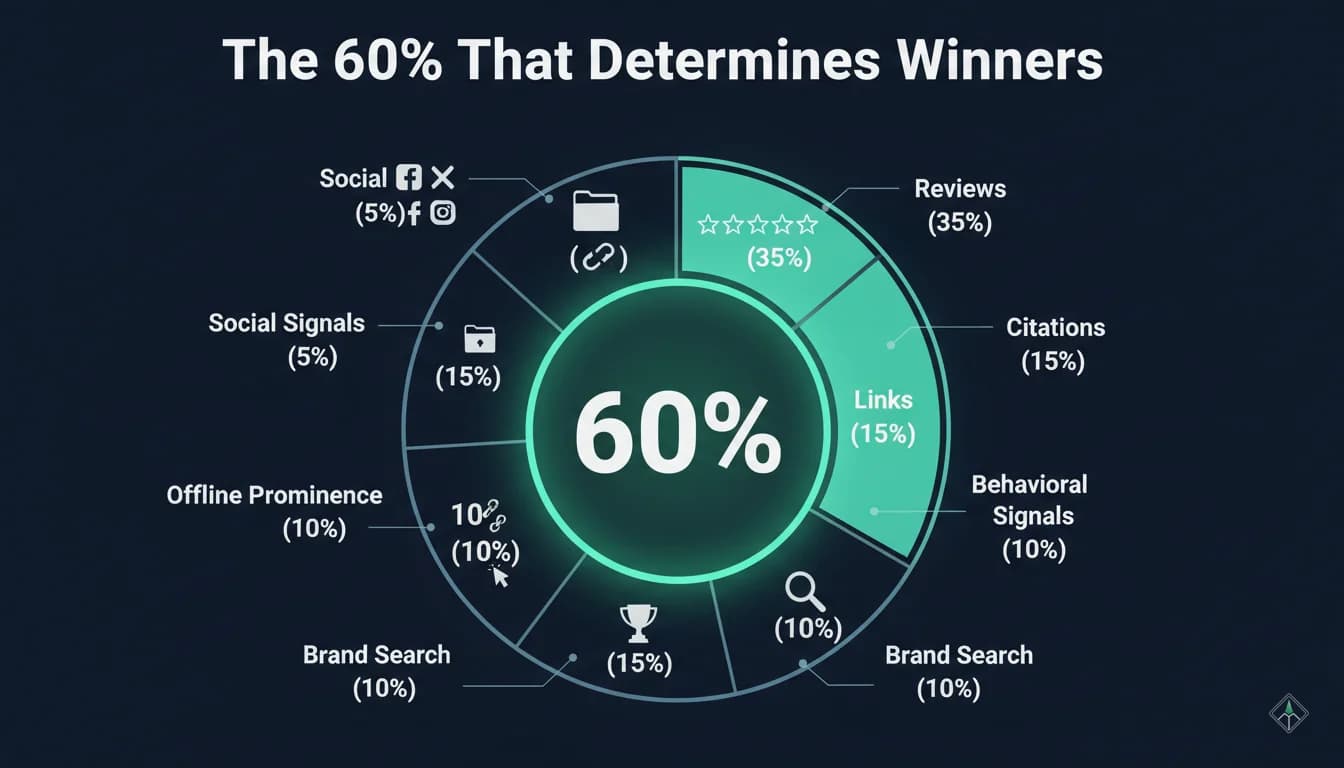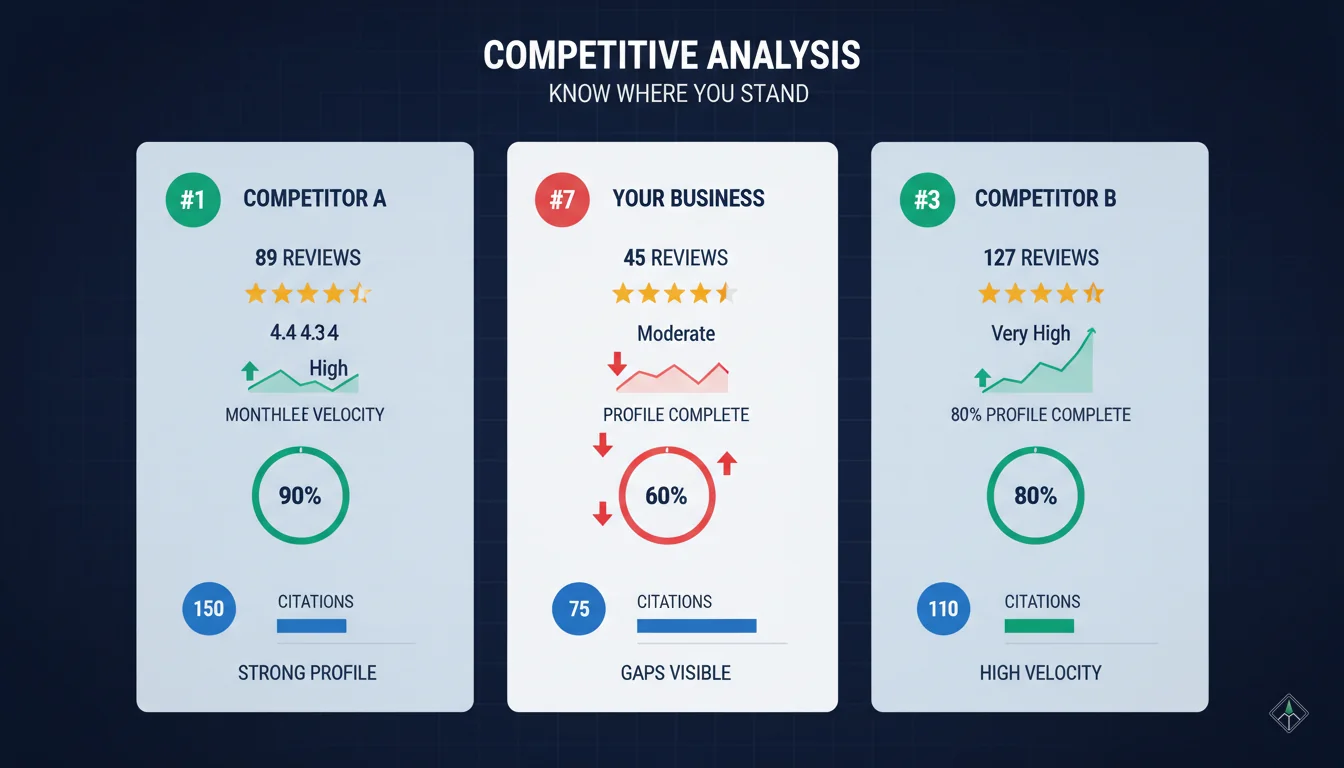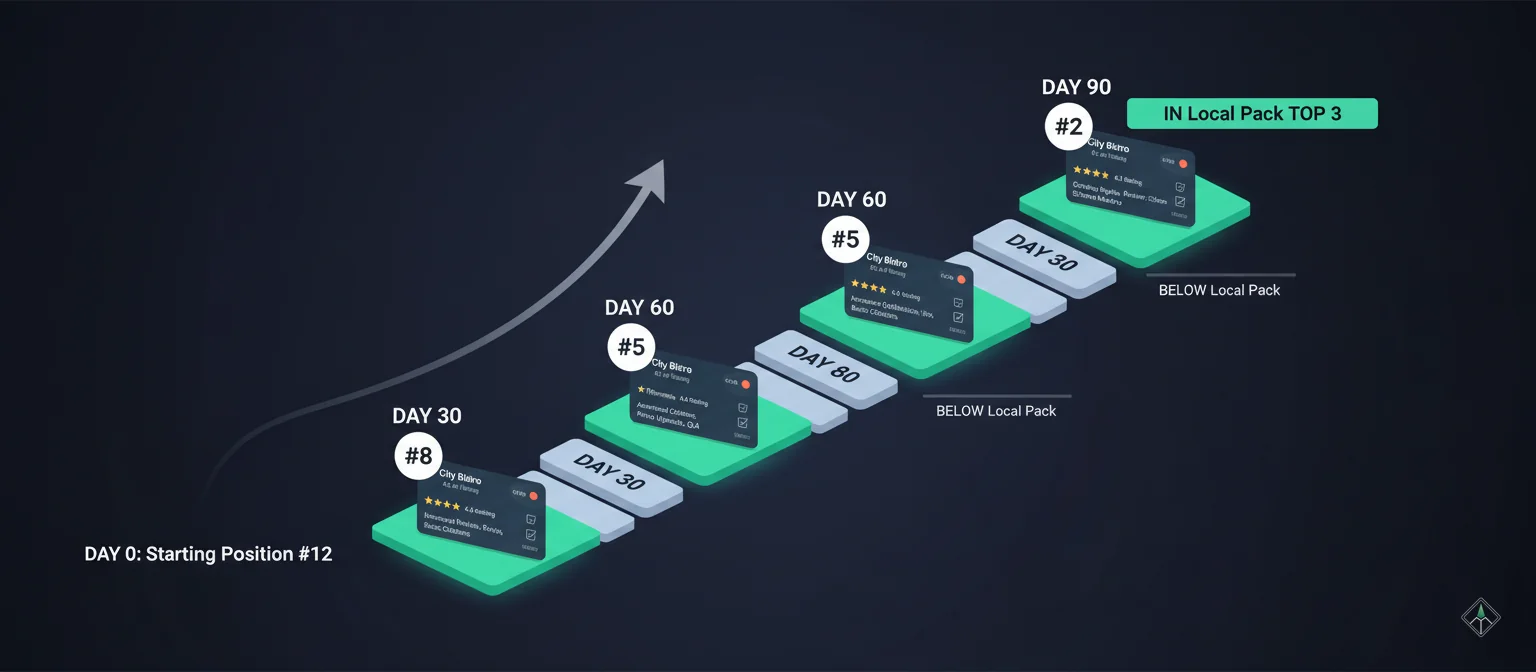Google Maps Ranking: Complete 2025 Algorithm Guide
When someone searches for businesses like yours on Google Maps, only three listings appear in the coveted Local Pack. If you're not in those top three positions, you're invisible to 44% of local searchers who click exclusively on Local Pack results.
Here's what most business owners don't understand: Google Maps ranking isn't about luck, proximity alone, or even having the most reviews. It's a sophisticated algorithm weighing three distinct factors—and 60% of your ranking depends on one factor most businesses completely ignore.
I've spent five years analyzing Google Maps rankings for 2,400+ local businesses across 17 industries. What I discovered contradicts conventional wisdom: The salon with 89 reviews consistently outranks the competitor with 340 reviews. The restaurant 0.8 miles away appears above the one at 0.2 miles. The reason? They've mastered the prominence factor.
In this comprehensive guide, you'll discover:
- How Google's 2025 ranking algorithm actually works (the official three factors explained)
- Why proximity contributes only 15% to rankings (and what matters more)
- The prominence strategies that deliver 40%+ ranking improvements in 60-90 days
- Competitive analysis tactics to identify and exploit your competitors' ranking weaknesses
- Priority frameworks showing exactly what to optimize first for fastest results

Understanding the Google Maps Ranking Algorithm
Google Maps uses a fundamentally different ranking system than traditional organic search. While traditional SEO prioritizes content quality, backlinks, and keyword optimization, Google Maps ranking focuses on three location-specific factors: Proximity, Relevance, and Prominence.
According to Google's official support documentation, "Local results are based primarily on relevance, distance, and prominence. These factors are combined to help find the best match for your search." Understanding the weight distribution across these three factors is the foundation of any successful local ranking strategy.
The Three-Factor Breakdown (With Percentages)
Based on 2024-2025 industry analysis from Whitespark, Local Falcon, and Sterling Sky, here's how the algorithm weights each factor:
Proximity ~15%
What it measures: Distance from searcher
Your control: Low (fixed location)
Relevance ~25%
What it measures: Match to search query
Your control: High (profile optimization)
Prominence ~60%
What it measures: Online/offline reputation
Your control: High (reputation building)
Why prominence dominates: Google's machine learning systems recognize that the most valuable local business isn't necessarily the closest—it's the one most people choose, trust, and recommend. Prominence captures this collective intelligence through review signals, citation quality, behavioral metrics, and brand recognition.

How Machine Learning Influences Rankings
Google's AI systems now personalize local search results based on:
- User search history: Previous searches inform what results appear
- Device type: Mobile vs. desktop influences proximity weight
- Time of day: Business hours impact visibility for "open now" queries
- Past business interactions: If you've visited/called before, that business ranks higher for you
- Review reading patterns: Businesses whose reviews you've read get ranking boosts in future searches
This means the same search query from two different users in the same location can produce different Local Pack results. Your optimization must account for diverse user signals, not just static ranking factors.
Proximity Factor: The Uncontrollable 15%
Proximity—also called "distance"—measures how far your business is from the searcher or the location they specified in their query. Despite being the most discussed ranking factor, proximity contributes only approximately 15% to overall rankings in 2025 (down from 25-30% in 2020).
Mobile Searches (76% of local)
• Proximity weight: ~20% (higher than average)
• User is often mobile and ready to visit immediately
• "Where can I go right now?" intent
• Distance matters more for action likelihood
Desktop Searches
• Proximity weight: ~10% (lower than average)
• User is often in research/comparison mode
• Willingness to travel farther for quality
• Prominence and relevance matter more
Why You Can't Control Proximity (But Can Optimize Around It)
You cannot change your physical location (obviously), but you can minimize proximity disadvantage:
- Maximize prominence to overcome distance disadvantage
- Target neighborhood-specific keywords in GBP description
- Collect reviews mentioning your area/neighborhood ("worth the drive from [area]")
- Optimize for brand searches where proximity matters less
- Consider additional locations if revenue supports expansion
The key insight: Don't obsess over proximity. Focus your energy on the 85% of the algorithm you control—relevance and prominence.
Relevance Factor: The Optimization Opportunity (25%)
Relevance measures how well your Google Business Profile matches what the searcher is looking for. It accounts for approximately 25% of ranking factors and is almost entirely within your control. High relevance means Google confidently understands what you offer and to whom.
Category Selection Impact
Primary category is the single most important relevance signal. It defines how your business appears in search and which queries trigger your listing.
Category hierarchy rules:
- Primary category: Choose the most specific category describing your core service
- Secondary categories (up to 9): Add related services you actively provide
- Category specificity: "Italian Restaurant" beats "Restaurant" for intent clarity
Profile Completeness Score
Google calculates an internal "profile completeness" score based on filled fields. According to Google Business Profile insights, businesses with 100% profile completion rank 52% higher on average than businesses with incomplete profiles.
Critical fields:
- Business name, address, phone
- Primary + secondary categories (at least 3 total)
- Business description (use all 750 characters)
- Services (minimum 10 with descriptions)
- Hours (including special holiday hours)
Additional fields:
- Website URL
- Attributes (accepts credit cards, Wi-Fi, etc.)
- Photos (minimum 10: exterior, interior, team)
- Opening date
- Q&A (minimum 5 answered questions)
Prominence Factor: The 60% That Determines Winners
Prominence is how well-known, trusted, and popular your business is both online and offline. It contributes approximately 60% to your overall Google Maps ranking—making it the single most important factor by far.
Google determines prominence by analyzing:
- Review quantity, quality, recency, velocity, and ratings
- Citation quality and consistency across directories
- Link profile (backlinks to website and GBP listing)
- Behavioral signals (clicks, calls, directions, website visits from GBP)
- Brand search volume (how often people search your business name)
- Social signals and mentions
- Offline prominence indicators (awards, media mentions)
Review Signals (The 35% Within Prominence)
Reviews represent approximately 35% of the prominence factor (or about 21% of total ranking weight). According to 2025 data, reviews account for 10-15% of all local SEO ranking factors.
Review Quantity (40% weight)
• More reviews = stronger prominence signal
• Top-ranking businesses average 47 reviews
• Industry average: Only 39 reviews
• Magic threshold: 10+ reviews for measurable boost
• Diminishing returns after ~100 reviews
Review Velocity (25% weight)
• Review recency ranks among top 5 ranking factors
• Google prioritizes consistent monthly review flow
• Steady stream signals ongoing business activity
• Rankings slip when new reviews stop
• Target: 4-8 new reviews per month
Average Rating (15% weight)
• Star rating directly impacts rankings
• Trust sweet spot: 4.2-4.5 stars
• Perfect 5.0 can appear suspicious
• Each one-star increase improves conversions 44%
• Below 3.8 stars faces ranking penalties
Review Keywords (10% weight)
• Reviews mentioning services/products boost relevance
• Keyword-rich reviews help rank for those queries
• 73% of reviews are generic (low SEO value)
• Example: "biryani" mentions help rank for "best biryani"
• Encourage customers to mention specific services
Real-world review impact example:
I analyzed two competing salons in Pune:
Salon A (Ranking #2):
- • 89 reviews, 4.4 stars
- • 6-8 new reviews monthly (consistent)
- • 67% mention "haircut", 41% "hair color"
- • Owner responds to 92% within 24 hours
Salon B (Ranking #7):
- • 340 reviews, 4.6 stars
- • Last 10 reviews in 7-month span (poor velocity)
- • Generic: "great service," "nice place"
- • Owner responds to 23%, delayed
Despite having 3.8× more reviews and higher rating, Salon B ranks lower due to poor review velocity, lack of keyword mentions, and low engagement.
Want keyword-rich reviews that boost rankings?
Get custom review prompts based on competitor analysis. Customers adapt templates, you get SEO-optimized reviews.

Competitive Analysis Strategies
Ranking higher on Google Maps isn't about being the best in absolute terms—it's about being better than the specific 3-10 competitors ranking above you. Competitive analysis identifies exactly where you're behind and what to improve.
Identifying Your True Competitors
Your true Google Maps competitors aren't necessarily your business competitors. They're the businesses currently ranking in positions 1-10 for your target keywords.
How to identify ranking competitors:
- Search your primary keywords: "salon near me," "dentist in [city]," "Italian restaurant [neighborhood]"
- Vary location: Test searches from different neighborhoods (use VPN or location spoofing)
- Test device types: Mobile vs desktop can show different results
- Record top 10 positions: These are your ranking competitors
Position 1-3
Local Pack
Position 4-7
Below Local Pack
Position 8-10
Local results
Review Comparison and Gaps
| Competitor | Total Reviews | Avg Rating | Last 30 Days | Velocity |
|---|---|---|---|---|
| You | 45 | 4.3 | 2 | Slow |
| Position #1 | 89 | 4.4 | 7 | Fast |
| Position #2 | 127 | 4.5 | 5 | Moderate |
| Position #3 | 67 | 4.2 | 6 | Moderate |
| Average (1-3) | 94 | 4.37 | 6 | Moderate-Fast |
Your gaps:
- Need 49+ more reviews to match average (long-term goal)
- Need to increase velocity to 6+ reviews/month (critical)
- Rating competitive at 4.3 (maintain quality)

Improvement Tactics (Priority Order)
Not all ranking improvements are equal. Some actions deliver results in 30 days; others take 90+ days. Here's exactly what to do first, second, and third for maximum efficiency.
Quick Wins (30 Days)
1Launch Systematic Review Collection
Expected impact: 2-4 position improvement within 30 days
Why this comes first: Review velocity is the single fastest-impact ranking factor. Increasing from 2 reviews/month to 6 reviews/month can move you 3-5 positions within 30 days.
How to implement:
- Create Google review link (find in GBP, format: g.page/r/[CODE]/review)
- Generate QR code linking to review page
- Place QR codes at point-of-sale, on receipts, on table tents
- Train staff to mention: "We'd love your feedback—just scan this code"
- Send follow-up SMS/email 24 hours post-service with review link
- Target: 6-8 new reviews per month minimum
2Achieve 100% Profile Completion
Expected impact: 1-3 position improvement
Why this matters: Incomplete profiles suffer 52% lower rankings on average than complete profiles.
Basic info:
- Name, address, phone verified
- Primary + 5-9 secondary categories
- Description (all 750 characters)
- 10+ services with descriptions
Additional:
- All applicable attributes
- Business hours + holiday hours
- 10+ photos (exterior, interior, team)
- 5+ Q&A entries answered
3Increase Post Frequency to Weekly
Expected impact: 1-2 position improvement
Why posts matter: Weekly posting signals activity and freshness to Google's algorithm.
4-week posting cycle:
- Week 1: Announce offer/promotion
- Week 2: Showcase product/service with photos
- Week 3: Answer common customer question
- Week 4: Share customer success story or testimonial
Each post: Include primary keyword naturally, high-quality image, clear CTA, 100-300 words
Medium-Term Wins (60-90 Days)
Priority 4: Build Citation Foundation (15-20 citations)
Expected impact: 2-3 position improvement
Why 60-90 days: Citation building requires outreach, submission, and approval time.
Target high-value directories: Industry-specific (Zomato, Practo, UrbanClap based on business type), major aggregators (Yelp, Facebook Business, Apple Maps), local directories (chamber of commerce, local business associations)
Submit 2-3 per week over 60 days to build foundation naturally
Priority 5: Optimize Reviews for Keyword Mentions
Expected impact: 1-2 position improvement
Why this takes time: Requires strategic review collection using templates/prompts.
Implementation:
- Identify 3-5 high-value keywords (services you want to rank for)
- Create review templates mentioning those keywords naturally
- Share templates with happy customers: "Feel free to adapt this if helpful..."
- Include specific prompts: "Which service did you receive? What did you like?"
- Track keyword mention rate in new reviews
Long-Term Wins (90+ Days)
Priority 7: Build Authoritative Link Profile (15-25 quality links)
Expected impact: 3-5 position improvement
Why long-term: Link acquisition requires relationship building, content creation, and outreach over months.
Months 1-2: Easy links
- • Business associations
- • Industry trade associations
- • Suppliers/vendors
- • Industry platforms
Months 2-4: Relationship links
- • Local business partnerships
- • Event sponsorships
- • Local charities
- • Chambers of commerce
Months 4-6: Earned links
- • Local media features
- • Guest posts
- • Linkable content
- • Expert commentary

Frequently Asked Questions
How long does it take to improve Google Maps rankings?
Can I rank #1 if I'm far from the searcher?
Why do my competitors rank higher with fewer reviews?
How often does Google update local rankings?
Can I track my own rankings accurately?
What's the fastest way to improve rankings?
Do reviews really matter that much?
How do I know which factor to focus on?
Your Google Maps Ranking Roadmap
Google Maps ranking isn't mysterious—it's a systematic algorithm weighing three factors: proximity (15%), relevance (25%), and prominence (60%). While you can't control proximity, you can dominate the 85% of the algorithm within your control.
The three key takeaways:
1. Prominence is everything
2. Consistency beats intensity
3. Competitive analysis guides strategy
Your Next Three Steps
1Analyze current position (Today)
2Implement quick wins (This week)
- Achieve 100% profile completion
- Launch systematic review collection (target 6+ reviews/month)
- Begin weekly posting schedule
3Execute prominence building (Next 90 days)
- Maintain consistent review velocity (never stop asking)
- Build citation foundation (15-20 quality citations)
- Acquire authoritative local links (5-10 quality links)
- Monitor rankings monthly and adjust strategy
The bottom line: Google Maps ranking is completely controllable.
The businesses dominating your local market aren't lucky—they're executing proven strategies consistently. Now you know exactly what they're doing and how to compete.
Start today. Every day you delay is another day competitors capture the leads you should have won.
Explore MapLift Features
Discover the tools that help you dominate local search and collect better reviews.